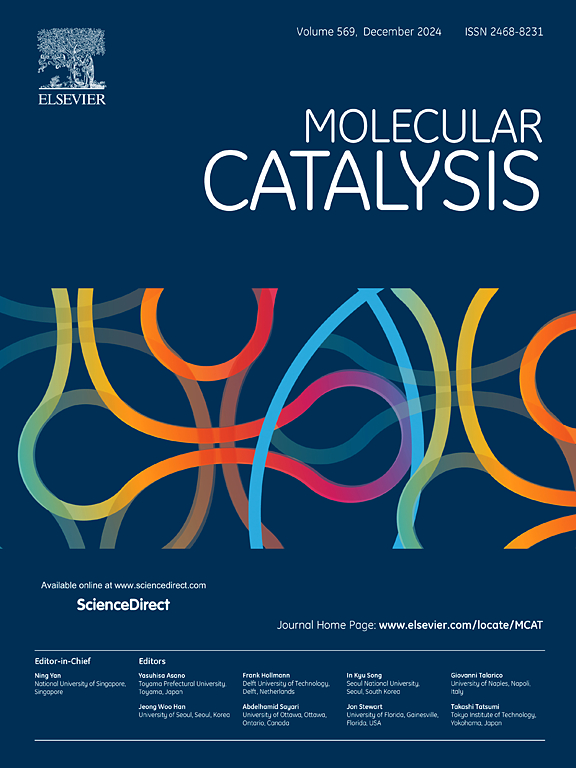MgO稳定ZrO2立方相负载Rh催化剂促进CO2甲烷化
IF 4.9
2区 化学
Q2 CHEMISTRY, PHYSICAL
引用次数: 0
摘要
本文报道了MgO掺入对ZrO2负载的Rh催化剂的结构和催化性能的影响。结果表明,MgO的加入促进了ZrO2立方相的形成,导致ZrO2的表面积、氧空位和表面碱度增加,这些因素共同增强了反应条件下CO2的吸附和活化。催化测试表明,低MgO含量(1.7 wt %)可产生最高的CO2转化率(325°C时为37.8%),而高MgO负荷会导致活性降低。值得注意的是,MgO含量最高的催化剂(5.5 wt %)表现出非常低的CO选择性(1.4%),表明抑制了逆水气转换(RWGS)反应,有利于缔合甲烷化途径。这种行为与表面碱度的增加有关,这显著影响了反应过程中表面中间体的性质,有利于通过CO2直接加氢生成甲烷。原位FTIR分析证实了关键中间体的存在,例如甲酸酯和Rh⁰-羰基物种。随着MgO含量的增加,rh0 -羰基的生成减少,进一步提高了对甲烷的选择性。本文章由计算机程序翻译,如有差异,请以英文原文为准。

Enhancing CO2 methanation over Rh catalyst supported on ZrO2 cubic phase stabilized by MgO addition
Here, it reports the influence of MgO incorporation on the structural and catalytic properties of Rh catalysts supported on ZrO2 for CO2 methanation. The results show that MgO addition promotes the formation of the cubic phase of ZrO2, leading to an increase in surface area, oxygen vacancies, and surface basicity, factors that collectively enhance CO2 adsorption and activation under reaction conditions. Catalytic testing revealed that a low MgO content (1.7 wt %) yielded the highest CO2 conversion (37.8 % at 325 °C), while higher MgO loadings resulted in decreased activity. Notably, the catalyst with the highest MgO content (5.5 wt %) exhibited remarkably low CO selectivity (1.4 %), indicating suppression of the reverse water-gas shift (RWGS) reaction in favor of the associative methanation pathway. This behavior is related to the increase in surface basicity, which significantly influences the nature of surface intermediates during the reaction, favoring methane formation via direct CO2 hydrogenation. In situ FTIR analysis confirmed the presence of key intermediates, such as formate and Rh⁰–carbonyl species. As MgO content increased, the formation of Rh0–carbonyl species diminished, further promoting selectivity toward methane.
求助全文
通过发布文献求助,成功后即可免费获取论文全文。
去求助
来源期刊

Molecular Catalysis
Chemical Engineering-Process Chemistry and Technology
CiteScore
6.90
自引率
10.90%
发文量
700
审稿时长
40 days
期刊介绍:
Molecular Catalysis publishes full papers that are original, rigorous, and scholarly contributions examining the molecular and atomic aspects of catalytic activation and reaction mechanisms. The fields covered are:
Heterogeneous catalysis including immobilized molecular catalysts
Homogeneous catalysis including organocatalysis, organometallic catalysis and biocatalysis
Photo- and electrochemistry
Theoretical aspects of catalysis analyzed by computational methods
 求助内容:
求助内容: 应助结果提醒方式:
应助结果提醒方式:


